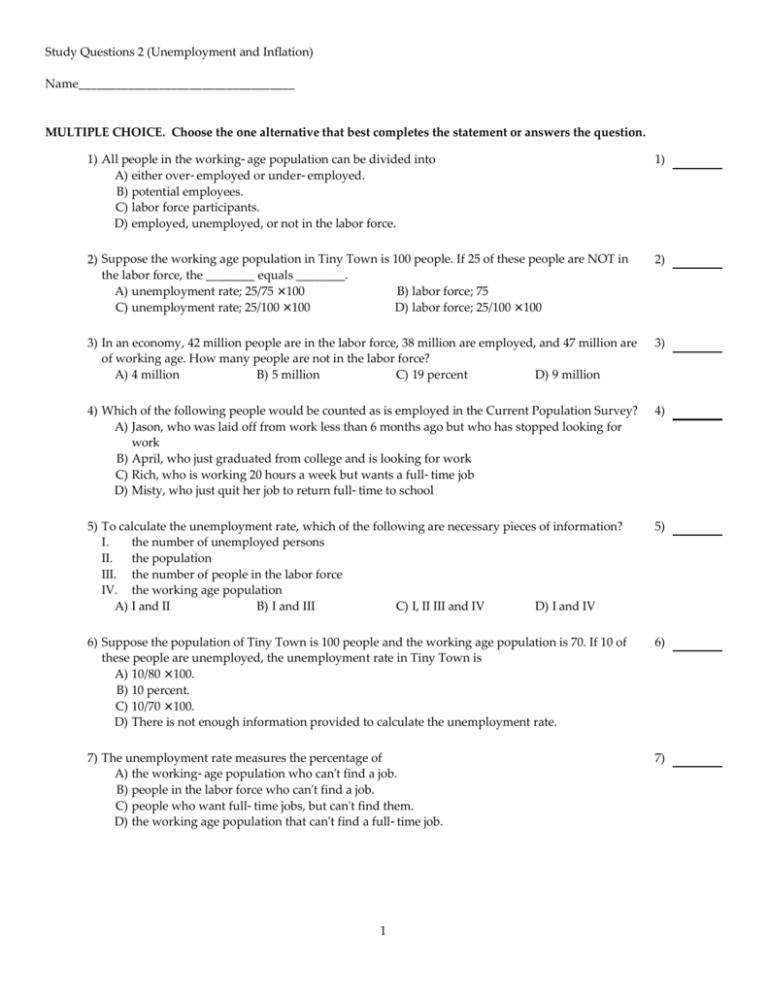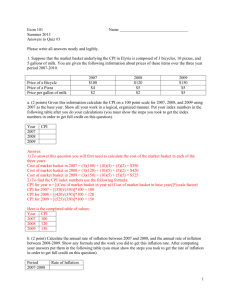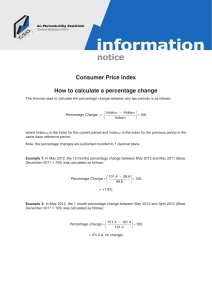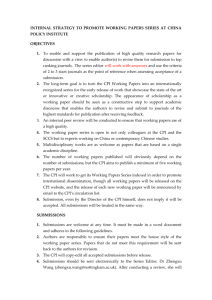Study Questions 2 (Unemployment and Inflation
advertisement

Study Questions 2 (Unemployment and Inflation) Name___________________________________ MULTIPLE CHOICE. Choose the one alternative that best completes the statement or answers the question. 1) All people in the working-age population can be divided into A) either over-employed or under-employed. B) potential employees. C) labor force participants. D) employed, unemployed, or not in the labor force. 1) 2) Suppose the working age population in Tiny Town is 100 people. If 25 of these people are NOT in the labor force, the ________ equals ________. A) unemployment rate; 25/75 × 100 B) labor force; 75 C) unemployment rate; 25/100 × 100 D) labor force; 25/100 × 100 2) 3) In an economy, 42 million people are in the labor force, 38 million are employed, and 47 million are of working age. How many people are not in the labor force? A) 4 million B) 5 million C) 19 percent D) 9 million 3) 4) Which of the following people would be counted as is employed in the Current Population Survey? A) Jason, who was laid off from work less than 6 months ago but who has stopped looking for work B) April, who just graduated from college and is looking for work C) Rich, who is working 20 hours a week but wants a full-time job D) Misty, who just quit her job to return full-time to school 4) 5) To calculate the unemployment rate, which of the following are necessary pieces of information? I. the number of unemployed persons II. the population III. the number of people in the labor force IV. the working age population A) I and II B) I and III C) I, II III and IV D) I and IV 5) 6) Suppose the population of Tiny Town is 100 people and the working age population is 70. If 10 of these people are unemployed, the unemployment rate in Tiny Town is A) 10/80 × 100. B) 10 percent. C) 10/70 × 100. D) There is not enough information provided to calculate the unemployment rate. 6) 7) The unemployment rate measures the percentage of A) the working-age population who can't find a job. B) people in the labor force who can't find a job. C) people who want full-time jobs, but can't find them. D) the working age population that can't find a full-time job. 7) 1 8) During a recession, people drop out of the labor force because they are unable to find a job. All else the same, this A) does not change the unemployment rate. B) increases the unemployment rate and the labor force participation rate. C) increases the unemployment rate. D) decreases the unemployment rate. 8) 9) Assume that the total labor force is 100 individuals with 10 unemployed. The unemployment rate is ________. Now assume that 10 people drop out of the labor force and that 10 remain unemployed. The new unemployment rate is ________. A) 10 percent, 11 percent B) 11 percent, 10 percent C) 10 percent, 9 percent D) 9 percent, 10 percent 9) 10) Suppose the working-age population is 220 million, the labor force is 150 million, and the unemployment rate is 10 percent. The number of unemployed people is A) 22 million. B) 37 million. C) 7 million. D) 15 million. 10) Want to work but Total Currently Not working no longer looking population employed and looking for for work (millions) (millions) work (millions) (millions) 80 40 2 4 11) In the table above, the size of the labor force is A) 80 million. B) 40 million. C) 42 million. 12) In the table above, the number of people officially unemployed is ________. A) 6 million B) 4 million C) 40 million D) 46 million. D) 2 million 11) 12) 13) Suppose the population is 220 million people, the labor force is 150 million people, the number of people employed is 130 million and the working-age population is 175 million people. What is the labor force participation rate? A) 85.7 percent B) 86.7 percent C) 68 percent D) 0.68 percent 13) 14) When an individual is frictionally unemployed, the unemployment arises in part from A) individuals searching for appropriate employment. B) the permanent elimination of jobs because of a change in the structure of the economy. C) a reduction in the overall demand for workers' skills. D) a short-term elimination of jobs because of a slowdown in business activity. 14) 2 Person A Now that the kids are in school for a full day, this person is looking for work and has interviewed for three jobs during the past two weeks. Person B This person has been laid off from a job but expects to be called back as soon as the economy improves. Person C This person has just graduated from college and will start a new job in three weeks. In the meantime this person will tour the great American beaches. Person D This person was laid off last year when new equipment was installed at the plant, reducing the number of workers needed. Shortly after being laid off, this person looked for a new job, was unable to find one, and then stopped looking for work. 15) The above table shows answers given by people interviewed in a government survey of households. Which person is a discouraged worker? A) A B) B C) C D) D 15) 16) A person quits her job in order to spend time looking for a better-paying job. This is an example of A) frictional unemployment. B) structural unemployment. C) seasonal unemployment. D) cyclical unemployment. 16) Item Movie tickets Bags of popcorn Drinks of soda Quantity 4 2008 Price $5.00 2009 Price $7.50 2 $3.00 $3.00 4 $1.00 $1.50 17) The information in the table above gives the 2008 reference base period CPI basket and prices used to construct the CPI for a small nation. It also has the 2009 prices. What is the value of the CPI for the reference base period, 2008? A) 100 B) 133 C) 140 D) 75 17) 18) Suppose that the number of jobs in the fishing industry decreases but the number of jobs in the travel industry increases. Initially, ________. A) the economy remains at full employment B) structural unemployment increases C) cyclical unemployment increases D) there is a shortage of workers in both sectors 18) 19) How would you best describe a manufacturing employee who has been fired because he was replaced by a robot (new technology) and does not have the skills necessary to help operate the robot? A) structurally unemployed B) entrant/reentrant C) cyclically unemployed D) job leaver 19) 3 Person A This person has just graduated from high school and is working at a part-time job but wants a full-time job. Person B At the age of 45, this person was laid off from the automobile industry when new equipment was installed and the person did not have the skills necessary to use the equipment. This person now is searching to find a new job. Person C As a result of this person's spouse being transferred to a job in a new city, this person is looking for a new job. Person D This person just graduated from college and is looking for an engineering job. In the meantime, this person is working full-time waiting tables. 20) The above table shows answers given by people interviewed in the Current Population Survey. Which people are structurally unemployed? A) B and C. B) A, B, and C C) A, B, C, and D D) A, B, and D 20) 21) Which type of unemployment increases during a recession? A) the natural unemployment rate B) structural unemployment C) cyclical unemployment D) frictional unemployment 21) 22) Full employment means that A) there is no cyclical or frictional unemployment. B) no one is unemployed. C) there is no structural or frictional unemployment. D) there is no cyclical unemployment. 22) 23) During a period of unpredictable inflation, A) the price level falls unpredictably. B) the Consumer Price Index falls. C) the value of money changes unpredictably. D) the economy is unharmed. 23) 24) The Consumer Price Index is a measure of the average of the prices paid by ________ for a fixed basket of consumer goods and services. A) urban consumers B) consumers living in cities with a population greater than 100,000 C) urban wage earners and clerical workers D) all consumers 24) 25) The consumer price index (CPI) A) compares the cost of the typical basket of goods consumed in period 1 to the cost of a basket of goods typically consumed in period 2. B) is the ratio of the average price of a typical basket of goods to the cost of producing those goods. C) measures the increase in the prices of the goods included in GDP. D) compares the cost in the current period to the cost in a reference base period of a basket of goods typically consumed in the base period. 25) 4 26) Suppose the Consumer Price Index for the year 2007 is 143.6. What does that number mean? A) Prices rose 143.6 percent over the reference base period, on average. B) On average, goods cost $243.60 each in 2007. C) Prices rose 43.6 percent over the reference base period, on average. D) On average, goods cost $143.60 each in 2007. 26) 27) If the basket of goods and services used to calculate the CPI cost $200 in the reference base period and $450 in a later year, the CPI for the latter year equals A) 225. B) 450. C) 200. D) 325. 27) Item Movie tickets Bags of popcorn Drinks of soda Quantity 4 2008 Price $5.00 2009 Price $7.50 2 $3.00 $3.00 4 $1.00 $1.50 28) The information in the table above gives the 2008 reference base period CPI basket and prices used to construct the CPI for a small nation. It also has the 2009 prices. What is the value of the CPI for 2009? A) 75 B) 140 C) 100 D) 133 28) 29) The CPI basket contains 400 oranges and 800 pens. In the base year, the price of an orange is $1.00 and the price of a pen is $0.75. This year, urban consumers each buy 300 oranges at $2.00 each and 850 pens at $1.00 each. The CPI this year is ________. A) 1.60 B) 62.5 C) 140 D) 160 29) 30) Suppose that last year the Consumer Price Index was 124; this year it is 130.7. What was the inflation rate between these years? A) 5.4 percent B) 6.7 percent C) 5.1 percent D) 30.7 percent 30) Year 2006 2007 2008 2009 Price level 91 100 110 121 31) In the above table, the inflation rate between 2006 and 2007 is approximately A) 1 percent. B) 0.9 percent. C) 10 percent. D) 100 percent. 32) In the above table, the inflation rate between 2007 and 2008 is approximately A) 10 percent. B) 9 percent. C) 110 percent. D) 100 percent. 5 31) 32) Item Books Pens 2008 Quantity Price 10 $30 20 $1 2009 Quantity Price 8 $50 15 $2 33) In 2008, consumers in Dexter consumed only books and pens. The prices and quantities for 2008 and 2009 are listed in the table above. The reference base period for Dexter's CPI is 2008. What is the cost of the CPI basket in 2008? A) $540 B) $320 C) $430 D) $335 33) 34) In 2008, consumers in Dexter consumed only books and pens. The prices and quantities for 2008 and 2009 are listed in the table above. The reference base period for Dexter's CPI is 2008. What is the CPI in 2008? A) 1.00 B) 100 C) 320 D) 3.20 34) 35) In 2008, consumers in Dexter consumed only books and pens. The prices and quantities for 2008 and 2009 are listed in the table above. The reference base period for Dexter's CPI is 2008. What is the cost of the CPI basket in 2009? A) $430 B) $320 C) $335 D) $540 35) 36) In 2008, consumers in Dexter consumed only books and pens. The prices and quantities for 2008 and 2009 are listed in the table above. The reference base period for Dexter's CPI is 2008. What is the CPI in 2009? A) 102 B) 129 C) 59 D) 169 36) 37) In 2008, consumers in Dexter consumed only books and pens. The prices and quantities for 2008 and 2009 are listed in the table above. The reference base period for Dexter's CPI is 2008. What is the inflation rate in 2009? A) zero B) 2 percent C) 31 percent D) 69 percent 37) 38) If this year's price level exceeds last year's, A) the inflation rate between these years has been positive. B) no relative price changes are occurring. C) deflation is occurring. D) the inflation rate is accelerating. 38) 39) If the inflation rate is negative, the price level in an economy is A) rising rapidly. B) falling. C) rising slowly. D) constant. 40) The bias in the CPI typically A) overstates inflation. B) cannot be measured or estimated. C) understates inflation. D) about half the time overstates and about half the time understates the inflation rate. 6 39) 40) ESSAY. Write your answer in the space provided or on a separate sheet of paper. Item Loaves of bread Jugs of soda Item Loaves of bread Jugs of soda Quantity (2006) 20 20 Price (2006) $3.00 $2.00 Quantity (2007) 22 30 Price (2007) $4.00 $1.50 41) The tables above give the purchases of an average consumer in a small economy. (These consumers purchase only loaves of bread and jugs of soda.) Suppose 2006 is the reference base period. a) What quantities are in the CPI basket? b) What is the cost of the CPI basket using 2006 prices? c) What is the cost of the CPI basket using 2007 prices? d) What is the CPI in 2007? Item Shampoo Pizza Item Shampoo Pizza Quantity (2006) 25 15 Price (2007) $2.35 $7.50 Quantity (2006) 25 15 Price (2007) $2.50 $7.75 42) The tables above give the purchases of an average consumer in a small economy. (These consumers purchase only shampoo and pizza.) Suppose 2006 is the reference base period. a) What is the cost of the CPI basket in 2006 and 2007? b) What is the CPI in 2006 and in 2007? c) What is the inflation rate between 2006 and 2007? Item Oranges Bananas Chicken Beef Bread Quantity (2007) 50 100 200 100 300 Price (2007) $0.90 $0.50 $2.00 $5.00 $1.75 Price (2008) $0.75 $0.95 $2.50 $4.80 $2.00 43) The table above gives the CPI basket for 2007 and 2008. Suppose that 2007 is the reference base period. a) What is the cost of the CPI basket in 2007? b) What is the cost of the CPI basket in 2008? c) What is the CPI for 2007? d) What is the CPI for 2008? 7 Category Working age population Labor force Employment Number (millions) 222.0 146.8 138.0 44) The Bureau of Labor Statistics reported the data in the table above for October 2003. a) Calculate the number of people unemployed. b) Calculate the number of people who are not in the labor force c) Calculate the unemployment rate. d) Calculate the labor force participation rate. 45) A typical household in Orangeland consumes only orange juice and shorts. Last year, which was the base year, the household spent $400 on juice and $120 on shorts. In the base year, juice was $2 a bottle and shorts were $10 a pair. This year, juice is $3 a bottle, shorts are $12 a pair, and a typical household has bought 180 bottles of juice and 14 pairs of shorts. a) What is the basket used in the CPI? b) Calculate the CPI in the current year. c) Calculate the inflation rate in the current year. d) Is the inflation rate that you've calculated likely to be biased? Why or why not? 8 Answer Key Testname: STUDY QUESTIONS 2 (UNEMPLOYMENT AND INFLATION) 1) D 2) B 3) B 4) C 5) B 6) D 7) B 8) D 9) A 10) D 11) C 12) D 13) A 14) A 15) D 16) A 17) A 18) B 19) A 20) A 21) C 22) D 23) C 24) A 25) D 26) C 27) A 28) B 29) D 30) A 31) C 32) A 33) B 34) B 35) D 36) D 37) D 38) A 39) B 40) A 41) a) The quantities in the CPI basket are the 2006 quantities because 2006 is the reference base period. So, the quantities are 20 loaves of bread and 20 jugs of soda. b) The cost of the CPI basket using 2006 prices is (20 loaves) × ($3) + (20 jugs) × ($2) = $100. c) The cost of the CPI basket using 2007 prices is (20 loaves) × ($4) + (20 jugs) × ($1.50) = $110. Note that the quantities used in this calculation are the quantities in the CPI basket. d) The CPI in 2007 equals 100 times the cost of the CPI basket at 2007 prices divided by the cost of the CPI basket at 2006 (base period) prices. The CPI equals 100 × ($110) ÷ ($100) = 110. 42) a) For 2006 the CPI basket costs $171.25. For 2007 the CPI basket costs $178.75. b) For 2006, the base period, the CPI is 100.0. For 2007 the CPI is ($178.75/$171.25) × 100, which is 104.4. c) Between the two years the inflation rate is equal to [(104.4 - 100.0)/100] × 100, which is 4.4 percent. 9 Answer Key Testname: STUDY QUESTIONS 2 (UNEMPLOYMENT AND INFLATION) 43) a) The cost of the CPI basket in 2007 is $1,520.00. b) The cost of the CPI basket in 2008 is $1,712.50. c) The CPI for 2007 is 100 because 2007 is the base period. d) The CPI for 2008 equals 100 × [$1,712.50 ÷ $1,520.00] = 112.66. 44) a) The labor force is the sum of the number of people employed plus the number of unemployed. So the number of people unemployed is the labor force minus the number of employed: 146.8 - 138.0 = 8.8 million. b) The number of people who are not in the labor force is the difference between the working age population and the labor force: 222.0 - 146.8 = 75.2 million. c) The unemployment rate is the number of unemployed as a percentage of the labor force: (8.8/146.8) × 100 = 6.0 percent. d) The labor force participation rate is the percentage of the working-age population who are in the labor force: (146.8/222.0) × 100 = 66.1 percent. 45) a) The CPI basket is the quantities bought in the base year. In the base year, a typical household spent $400 on juice at $2 a bottle, so the quantity of juice bought was $400/$2 = 200 bottles. The household spent $120 on shorts at $10 a pair, so the quantity of shorts bought was $120/$10 = 12. Thus the CPI basket is 200 bottles of juice and 12 pairs of shorts. b) The cost of the CPI basket last year was $400 + $120 = $520. The cost of the CPI basket in the current year is $3 × 200 + $12 × 12 = $744. So the CPI is ($744/$520) × 100 = 143.1 c) The inflation rate is the percentage change in the CPI. Because the last year was also the base year, the CPI last year was 100. So the inflation rate for the current year is [(143.1 - 100)/100] × 100, which is 43.1 percent. d) The calculated CPI is likely to overstate inflation because of the commodity substitution bias. The relative price of shorts has fallen from 5 to 4 bottles of juice. This fall led consumers to buy more shorts and less juice. As a result, the actual consumer basket in the current year is less expensive than the CPI basket. The CPI ignores this commodity substitution, and so overstates the inflation rate. 10







